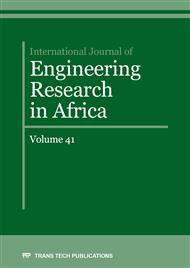[1]
Susmita D.S., Anshuman S., Shivani G.V. and Meenakshi G., (2014) Preparation of Starch-Poly Vinyl Alcohol (PVA) Blend Using Potato and Study of Its Mechanical Properties. International Journal of Pharmaceutical Science Invention, 3(3):33-37.
Google Scholar
[2]
Watcharakul S., Umsakul K., Hodgson B., Tanrattanakul V. and Chumeka W. (2012) Biodegradation of a blended starch/natural rubber foam biopolymer and rubber gloves by Streptomyces coelicolor CH13. Electronic Journal of Biotechnology. 15(1) http://dx.doi.org/10.2225/vol15-issue1fulltext-10.
DOI: 10.2225/vol15-issue1-fulltext-10
Google Scholar
[3]
Hoornweg D. and Bhada-Tata P. (2012). What a Waste: A Global Review of Solid Waste Management. Urban development series; knowledge papers no. 15. World Bank, Washington, DC. https://openknowledge.worldbank.org/handle/10986/17388.
Google Scholar
[4]
D'Alessandro, N. (2014). 22 Facts about Plastic Pollution. Retrieved March 24, 2018, from https://www.ecowatch.com/22-facts-about-plastic-pollution-and-10-things-we-can-do-about-it-1881885971.html.
Google Scholar
[5]
Halden R.U. (2010). Plastics and health risks. Annual Review of Public Health. 31(1):179–194. [PubMed:20070188].
DOI: 10.1146/annurev.publhealth.012809.103714
Google Scholar
[6]
Borghei M., Karbassi A.R., Khoramnejadian S., Oromiehie A. & Javid A.H. (2010), Microbial biodegradable potato starch based low density polyethylene, African Journal of Biotechnology, 9(26):4075-4080.
Google Scholar
[7]
Gichuki S.T., Carey E., Mwanga R., Kapinga R., Ndolo P.J. and Kamau J.W. (1998), Evaluation of Sweetpotato Seeding Progenies in Kenya, Uganda and Tanzania. In: Root Crops and Poverty Alleviation, Akoroda, M.O. and I.J. Ekanayake (Eds.). International Institute of Tropical Agriculture, Ibadan, Nigeria, pp: 461-465.
Google Scholar
[8]
Oyebisi S. O., Olutoge, F. A., Ofuyatan, O. O., Abioye, A. A. (2017). Effect of corncob ash blended cement on the properties of lateritic interlocking blocks. Progress in Industrial Ecology – An International Journal, 11 (4), 373-387.
DOI: 10.1504/pie.2017.092729
Google Scholar
[9]
Ajayi, O. O., Omowa, O. F., Abioye, O. P., Omotosho, O. A., Akinlabi, E. T., Akinlabi, S. A., Abioye, A. A., Owoeye, F. T., and Afolalu, S. A. (2018). Experimental Investigation of the Effect of ZnO-Citrus sinensis Nano-additive on the Electrokinetic Deposition of Zinc on Mild Steel in Acid Chloride. The Minerals, Metals & Materials Society, TMS 2018 147th Annual Meeting & Exhibition Supplemental Proceedings, The Minerals, Metals & Materials Series.35-40.
DOI: 10.1007/978-3-319-72526-0_4
Google Scholar
[10]
Mwanja Y.P., Goler E.E. and Gugu F.M. (2017). Assessment of root and vine yields of sweet potato (Ipomoea batatas (L.) Lam) landraces as influenced by plant population density in Jos-Plateau, Nigeria. International Journal of Agricultural Research, 12: 88-92.
DOI: 10.3923/ijar.2017.88.92
Google Scholar
[11]
Ikada Y. & Tsuji H., (2000), Biodegradable polyesters for medical and ecological applications, Macromolecular Rapid Communications, 21(3):117-132.
DOI: 10.1002/(sici)1521-3927(20000201)21:3<117::aid-marc117>3.0.co;2-x
Google Scholar
[12]
Rutkowska M., Heimowska A., Krasowska K. and Janik H. (2002). Biodegradability of Polyethylene Starch Blends in Sea Water. Polish Journal of Environmental Studies. 11(3):267-274.
Google Scholar
[13]
Cho, H. S., Moon, H. S., Kim, M., Nam, K., & Kim, J. Y. (2011). Biodegradability and biodegradation rate of poly(caprolactone)-starch blend and poly (butylene succinate) biodegradable polymer under aerobic and anaerobic environment. Waste Management, 31(3), 475–480. https://doi.org/10.1016/j.wasman.2010.10.029.
DOI: 10.1016/j.wasman.2010.10.029
Google Scholar
[14]
Mostafa N.A., Awatef A.F., Hala M.A. and Aghareed M.T. (2018), Production of Biodegradable Plastic from Agricultural Wastes, Arabian Journal of Chemistry. (11):546-553.
DOI: 10.1016/j.arabjc.2015.04.008
Google Scholar
[15]
Makhtar, N. S. M., Rais, M. F. M., Rodhi, M. N. M., Bujang, N., Musa, M., & Hamid, K. H. K. (2013). Tacca leontopetaloides starch: New sources starch for biodegradable plastic. Procedia Engineering, 68, 385–391. doi.org/10.1016/j.proeng.2013.12.196.
DOI: 10.1016/j.proeng.2013.12.196
Google Scholar
[16]
European Parliament and Council. Regulation (EC) No 1907/2006 of the European Parliament and of the Council of 18 December 2006 concerning the Registration, Evaluation, Authorisation and Restriction of Chemicals (REACH).
DOI: 10.1016/j.fos.2016.03.026
Google Scholar
[17]
Chinaglia S., Tosin M. & Degli-Innocenti F. (2018). Biodegradation rate of biodegradable plastics at molecular level. Polymer Degradation and Stability, 147:237-244. https://doi.org/10.1016/j.polymdegradstab.2017.12.011.
DOI: 10.1016/j.polymdegradstab.2017.12.011
Google Scholar
[18]
Leonel M (2007). Analysis of the shape and size of starch grains from different botanical species. Ciênc. Tecnol. Aliment., 27(3): 579-588.
Google Scholar
[19]
Ladeira T., Souza H., Pena R. (2013). Characterization of the roots and starches of three cassava cultivars. International Journal of Agricultural Science Research, Vol. 2(1), pp.012-020.
Google Scholar
[20]
Mostafa, N.A., Awatef, A.F., Hala, M.A., Aghareed, M.T., 2018. Production of Biodegradable Plastic from Agricultural Wastes, Arabian Journal of Chemistry, Volume 11, pp.546-553.
DOI: 10.1016/j.arabjc.2015.04.008
Google Scholar
[21]
Fakinle, B. S., Odekanle, E. L., Olalekan, A. P., Odunlami, O. A., Sonibare, J. A., 2016. Impacts of polycyclic aromatic hydrocardons from vehicular activities on the ambient air quality of Lagos mega city. Environ Qual Manage., Wiley Periodicals, Inc 2018; Volume 27, pp.73-78.
DOI: 10.1002/tqem.21563
Google Scholar
[22]
Dong, A.J., Zhang, J.W., Jiang, K., Deng, L.D., 2008. Characterization and in vitro Degradation of Poly (octadecanoic anhydride), Journal of Material Science. Volume 19, pp.39-46.
Google Scholar
[23]
Yang, J., Webb, A.R., Pickerill, S.J., Hageman G., Ameer, G.A., 2006. Synthesis and Evaluation of Poly (diol citrate) Biodegradable Elastomers. Biomaterials, Volume 27, pp.1889-1898.
DOI: 10.1016/j.biomaterials.2005.05.106
Google Scholar


